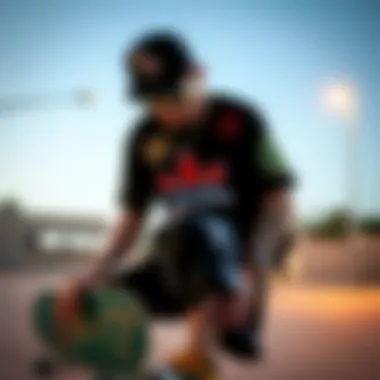T-Shirts and Patches: A Deep Dive into Skate Culture


Intro
In the rich tapestry of skate culture, t-shirts have become more than just a piece of fabric; they are a canvas of personal expression and identity. The addition of patches—symbols of affiliations, experiences, or simply stunning designs—has further transformed the humble t-shirt into a powerful emblem of the skateboarding lifestyle. These garments share tales of rebellion, individuality, and community, echoing the ethos of the skate scene.
As we peel back the layers of this intersection, we will explore how these patched t-shirts reflect cultural relevance, the artistry of design, and the DIY spirit that runs deep in skateboarding. The impact goes far beyond aesthetics; these items serve as a means to connect, communicate, and express one’s self in a world where authenticity reigns supreme.
Recognizing the need for practical advice, we will delve into integrating patched t-shirts into your skate wardrobe effectively, regardless of your skill level or time spent on the board. There’s something for everyone in the vibrant universe of t-shirts and patches that adds depth to the skateboarding experience.
Join us on this journey as we unearth the dual significance of these items for skateboarders, enthusiasts, and those keen on understanding the heartbeat of skate culture.
Preamble to T-Shirts with Patches
In the realm of skate culture, where form meets function, t-shirts adorned with patches have carved out an essential niche. They are more than just fabric; they embody a lifestyle, a story, and an identity. This section explores the pivotal role of t-shirts with patches, shedding light on their significance within the skateboard community.
T-shirts in skate culture serve as a canvas for self-expression. Each patch sewn or ironed on represents a fragment of personal history or communal attachment. Whether it’s a logo from a favorite skate shop, a symbol of a cherished local crew, or artwork from a beloved graffiti artist, these patches are badges of honor. They signify affiliation, acceptance, and a shared passion for skating.
Benefits of T-Shirts with Patches
One of the primary benefits of these t-shirts is their versatility. They can be worn casually at a skate park while practicing tricks or dressed up for a local gig. The patchwork allows skaters to customize their gear, ensuring that no two shirts are alike. This uniqueness mirrors the individuality cherished in skate culture, where it’s not about conforming but standing out.
Additionally, patches can function as conversation starters. A well-placed patch might lead to a discussion about a skating event, a favorite board shop, or even shared experiences on the board. This feature enhances community connections and reinforces the sense of belonging among skaters and enthusiasts alike.
Considerations When Choosing T-Shirts with Patches
When selecting t-shirts, there are a few considerations that skaters should keep in mind. Fabric quality matters—look for durable materials that can withstand the wear and tear of active use. The cut and fit also play a crucial role. A loose fit might be more comfortable for skating, while a tighter fit might suit streetwear aesthetics better.
To summarize, t-shirts with patches are far more than simple clothing items in skate culture. They represent identity, community, and a unique form of expression that resonates deeply with skaters worldwide. By understanding these garments' significance, one can appreciate how they contribute richly to the culture surrounding skating.
"In the world of skateboarding, every patch tells a story. Wear it with pride."
For those interested in exploring more about the evolution of t-shirts and patches in skate culture, sources like Wikipedia, Britannica, and various threads on Reddit provide valuable insights.
Historical Context of T-Shirt Culture
The history of t-shirts is also a record of cultural transformation, especially in the skate culture realm. T-shirts did not just evolve as a form of clothing; they turned into statements of identity and expressions of rebellion. In skate culture, where individuality is prized, the t-shirt became a canvas for personal stories through patches and designs. Grasping the historical context of t-shirts helps to appreciate their current role in the contemporary skateboarding scene. By delving into their origins and the critical evolution that accompanied the rise of skateboarding, we will unveil how each thread of this narrative contributes to the complex tapestry of skate culture.
Origins of the T-Shirt
T-shirts originated as simple undergarments in the late 19th century, primarily crafted from cotton and designed for utility. By the 1950s, they began to emerge as standalone pieces of clothing, often prominently worn by icons such as Marlon Brando and James Dean. As society transitioned through various cultural revolutions—especially the countercultural movements of the 1960s—the t-shirt evolved past its utilitarian roots. It transformed into a medium for self-expression and political statements alike.
As skate culture began to take shape in California during the late 1960s and early 1970s, t-shirts were soon adopted by skateboarders who saw in them an opportunity to showcase individuality. Iconic brands like Vans, Powell Peralta, and Santa Cruz began producing shirts that celebrated this new lifestyle—a lifestyle that valued freedom, creativity, and a touch of rebellion. Skateboarders utilized t-shirts to signify affiliation with particular crews or brands, serving as cultural markers within the broader skate community.
Evolution into Skate Fashion
As skateboarding grew from a niche sport into a global phenomenon, the evolution of the t-shirt as a fashion item became intertwined with the sport’s progression. The 1980s heralded new styles, heavily influenced by punk rock and street art, which led to the rise of graphic tees—bold designs came to reflect the raw culture of skating.
Similarly, as the t-shirt continued to catch the eye of the mainstream fashion industry, its role shifted. Skate brands began to sell not just clothing, but a way of life—one where each design conveyed a different story or philosophy. In all this change, patches emerged as significant additions, allowing skateboarders to infuse a personal touch into their attire.
"In skate culture, the t-shirt acts as both a uniform and a personal manifesto, reflecting the ever-evolving identity of its—skateboarding community."
T-shirts became platforms for local artists and independent designers to showcase their art, creating a unique blend of fashion and artistry. As skate culture spread, so did the popularity of patched t-shirts—each patch carrying its own meaning, representing clubs, brands, or even personal achievements. The ongoing fusion of t-shirts with patches continues to maintain relevance in the skate scene today, reflecting not just the sport's ethos, but also the societal shifts that have influenced it.
In summary, the historical context of t-shirts is pivotal to understanding their role in skate culture today. As styles have progressed and societal norms have shifted, the humble t-shirt has become a medium for expression, a canvas for identity in an ever-evolving landscape of creativity and rebellion.
The Role of Patches in Skate Culture
Patches serve as vital components in the fabric of skate culture, weaving together individual stories and collective experiences. This section highlights their significance, emphasizing how they function as symbols of community and personal expression. Within the realm of skateboarding, these decorative elements transform plain t-shirts into canvases that narrate tales of identity, rebellion, and creativity. The act of applying patches goes beyond mere aesthetics; it’s a rite of passage, a way for skaters to convey who they are and what they stand for.
Symbols of Identity and Belonging
Skateboarding thrives on a foundation of identity. Patches play an indispensable role in this, often acting as markers of belonging to a specific subculture or skate crew. When a skater dons a patched shirt, it’s not just about the threads; it’s about the statement that comes with it. Each patch can symbolize an ideological stance, a tribute to a beloved brand, or a nod to skate legends. For instance, a skull emblem may imply a connection to a no-nonsense skating style, while flowers might signal a more laid-back, free-spirited approach.


In the ever-evolving landscape of skate culture, authenticity reigns supreme. Many skaters opt for patches that resonate with their personal experiences or beliefs. The customization of t-shirts with patches fosters a sense of ownership and individualism, encouraging an environment where diversity in style and expression is not only accepted but celebrated.
A notable example is the use of patches from brands like Thrasher, which have become synonymous with skateboarding culture itself. These small insignias have long-standing histories tied to the craft, influencing how skaters perceive themselves and how they are perceived by others.
Patches as a Form of Expression
The patches sewn onto t-shirts serve as a powerful tool for personal expression. They help skaters voice their opinions, display their creativity, and even share their humor. Each patch, whether it represents a favorite skate spot, a social statement, or a whimsical design, communicates something unique about the wearer. This expressive potential makes patches a preferred method of celebrating individuality in a communal setting like skate parks.
In terms of design, the possibilities are virtually limitless. Skaters can choose patches that reflect their interests, whether that be a band they love, an art style they appreciate, or a message they feel deeply about. The act itself of sewing or ironing on these patches becomes an engaging process, allowing skaters to curate their outfits actively.
"A patch isn't just a piece of fabric; it's a reflection of who you are in the skate community."
Ultimately, the integration of patches in skate culture has deepened the emotional connection between skaters and their attire. As a form of self-expression, they carry layers of meaning that go far beyond fashion. Each patched t-shirt embodies the spirit of skateboarding, encapsulating the lifestyle, the struggles, and the triumphs of its enthusiasts. These garments are living records of skates' journeys, perfectly blending style with the heart and soul of skate culture.
Popular Designs and Themes in Patchwork
Patchwork designs in the context of t-shirts and skate culture are not merely decorative; they serve as a vibrant tapestry of identity and expression. In a world where individuality is highly prioritized, the choice of patches can convey personal narratives, affiliations, and even a sense of rebellion. This section dives into the intricate world of patchwork designs, emphasizing their role in the skateboarding culture.
A patch isn't just a piece of cloth stitched to a shirt; it often tells a story or represents a passion, hobby, or affiliation. For skaters, patches can signify the brands they endorse, the organizations they support, or even their favorite tricks. This blend of fashion with personal significance creates a dynamic visual language that resonates deeply within the community.
Common Motifs and Their Meanings
When it comes to common motifs seen in patched t-shirts, certain symbols frequently reappear, each imbued with its own meaning. For instance:
- Skull and Crossbones: This imagery evokes a sense of defiance and daredevil spirit which aligns with the audacity associated with skateboarding.
- Floral Patterns: Often seen as juxtaposed with the rough and tumble image of skate culture, floral designs can represent beauty amidst chaos, showing that skaters appreciate aesthetics just as much as they do adrenaline.
- Graffiti Art: Colorful, urban designs resonate with many skaters who see their life as a canvas, embodying the essence of street art and its roots in rebellion and authenticity.
- Retro Logos: Many t-shirt patches hark back to classic brands or faded skate shops, inviting nostalgia while reinforcing community ties and the importance of skate history.
"A patch can whisper the stories of journeys taken and not taken; they’re like badges of honor stitched in fabric."
These motifs are not chosen lightly. They reflect the skater's personal journey and serve as a powerful form of non-verbal communication within the community. They tell others about who the wearer is, where they’ve been, and what they stand for.
Collaborations with Artists and Brands
In today's landscape, collaborations between artists and brands have taken patchwork design to new heights. Custom patches often come from partnerships with renowned visual artists, turning a simple t-shirt into a wearable piece of art. Brands like Supreme or Thrasher lead the way in creating unique patch designs during special collaborations that draw on creative artists from various backgrounds.
These collaborative efforts not only infuse fresh creativity into patch design but also drive the narrative of skate culture as an ever-evolving movement. They enable artists to reach new audiences while offering skaters exclusive designs that hold value and appeal.
- Limited Edition Releases: Often, patches released in collaboration with artists are limited in number. This moves these patches beyond mere fashion items into the realm of collectible art. Skaters keen on expressing their unique style flock to these limited runs.
- Community Engagement: Such collaborations often spark conversations and engagements within the skating community, leading to events, exhibitions, or online discussions around the designs, the artists, and their vision. It's a thriving ecosystem of creativity.
The merging of artist sensibilities with commercial brands amplifies the cultural relevance of patched t-shirts. The act of wearing such apparel becomes a subtle nod to not just a hobby, but also to art, innovation, and community spirit.
Understanding the designs and themes that flow through patched t-shirts gives both skaters and enthusiasts insight into the cultural dialogues at play within skate culture. Each patch holds a piece of that larger story, becoming integral to the identity and spirit of the skateboarding community.
DIY Patch Applications
The DIY approach to applying patches onto t-shirts is central to its significance in skate culture. This practice not only allows skaters to make the clothing uniquely their own but also reinforces a sense of community and creativity. In the world of skateboarding, where personal identity matters, DIY patch applications provide a means for skaters to express themselves freely and without limitation. They can showcase personal interests, affiliations, or messages.
Choosing the Right Patches
When selecting patches, the possibilities are as varied as the individuals who skate. Skaters often look for designs that resonate with their identity or align with their aesthetic. This involves considering:
- Size: Bigger patches can make a bold statement, while smaller ones might be more subtle. It depends on what the skater wants to convey.
- Design: From colorful graphics to minimalistic emblems, the design should reflect one's personality. Rebellious imagery, vintage logos, or even customized artwork can be valid choices.
- Material: Durability is key, especially in skate culture where the clothing faces wear and tear. Look for patches made from sturdy fabrics that can withstand the lifestyle.
These considerations not only impact appearance but also affect how well the patches hold up under regular usage.
Techniques for Application
Applying patches to a T-shirt can be achieved through various techniques, each with its unique flavor and practicality. Here, we'll dig into three popular methods: iron-on, sewing, and adhesive options.
Iron-on methods
Iron-on methods offer a straightforward way to attach patches and come packed with convenience. The key characteristic of this method lies in its simplicity, making it a popular choice for those who may not have sewing skills. The process generally involves:
- Placing the patch on the desired spot of the fabric.
- Covering it with a thin cloth to protect the patch and the shirt.
- Using a hot iron to transfer heat onto the patch for adhesion.


This method is beneficial because it allows for a durable application without the need for sewing expertise. However, ensure proper heat settings; too high can scorch the fabric, while too low may not provide a strong bond.
Sewing techniques
Sewing techniques provide a more traditional approach to affixing patches. This method is particularly favored for its strength and longevity. The key characteristic of sewing is the control it offers, as skaters can specify exactly how secure they want the patch to be. Some points to consider include:
- Using a sewing machine or hand-stitching based on personal preference.
- Opting for contrasting thread colors can create an eye-catching border around the patch.
The advantage of sewing is its resistance to wear and tear, making it ideal for active lifestyles. On the downside, it does require a bit of know-how and can be time-consuming compared to other methods.
Adhesive options
Adhesive options offer an alternative for quick and easy application, ideal for those who want an uncomplicated process. The characteristic of adhesives is their mess-free nature, allowing patches to be securely attached without tools. Various adhesive products, such as fabric glue or double-sided tape, can be utilized.
- Fabric adhesives are typically strong enough for most fabrics and can be used for both temporary and permanent applications.
- Double-sided tape provides a quick fix but may not hold up as well through heavy wear.
While this method allows for flexibility and speedy application, it may require touch-ups over time, especially in an environment as dynamic as skate culture.
Maintaining Patched T-Shirts
Once the patches are applied, maintaining them is essential to prolong the life of both the patches and the t-shirt. Regular washing should be done with care.
- Washing inside out helps protect the patches from friction.
- Air drying is preferable to avoid heat from a dryer, which can loosen adhesives.
Following these simple steps enhances the longevity of patched garments, allowing skaters to continue expressing their individual styles.
The Intersection of Style and Comfort
Skate culture is not merely a hobby; it’s a way of life. In this realm, t-shirts and patches serve a dual purpose—not only do they make bold style statements, but they also provide the comfort needed for the physical demands of skateboarding. Finding the proper equilibrium between these two elements is crucial for both aesthetic appeal and practicality when selecting attire. Skateboarding often includes long hours on the board, maneuvers that require flexibility, and an environment where comfort can quickly turn to discomfort if the wrong materials are worn. Therefore, every choice in fabric and design can significantly influence a skater's experience.
Selecting the Right Fabrics
Choosing the right fabric is a game changer. The fabric of a t-shirt can determine how a skater feels during a session. Skateboarding calls for clothing that allows for movement while being breathable. Cotton, for instance, is a popular choice, thanks to its softness and breathability, helping to keep skaters cool in the sweltering heat. However, cotton can absorb moisture, making it heavy and uncomfortable when drenched with sweat. On the other hand, blends that include polyester can offer moisture-wicking properties, keeping the wearer dry, albeit sometimes at the cost of comfort and feel against the skin.
Some skaters opt for lightweight, stretchy fabrics that contribute to a flexibility that t-shirts with a little spandex provide. These materials are perfect for performing tricks while ensuring the wearer looks stylish in the process. When selecting fabrics, skaters should consider the weather conditions they usually skate in—water-resistant materials might be prized in rainy regions, while breathable fabrics are crucial in hotter climates.
Fit and Cut Considerations
Another vital aspect of t-shirt selection is the fit and cut, which is just as important as the fabric itself. A loose fit is favored by many within the skate community, as it allows for unrestricted movement during intense tricks and stunts. That said, a fit that is too baggy can lead to snagging on the board or even cause accidents during skating. Therefore, opting for a relaxed fit that still hugs the body at critical points can prevent this issue.
Conversely, some skaters prefer a more fitted look, emphasizing their style while enjoying the convenience of form-fitting garments that complement their body shape. Length also matters; t-shirts that are too short can ride up as skaters perform tricks, which is distracting and uncomfortable. Finding a happy medium is essential.
"The right t-shirt is like a second skin for a skater—it should feel natural and fit right, giving them confidence to push their limits."
In summary, the right balance of style and comfort in t-shirts with patches is integral to the skate experience. Whether it’s about fabric, fit, or the way patches depict identity, these choices reflect personal expression while supporting the functionalities required for the sport. As skaters progress and push boundaries, the importance of these elements grows, shaping both the culture and individual experiences.
Cultural Significance of Patched T-Shirts
Patched t-shirts hold a distinct cultural significance within the skateboarding community, serving not just as an item of clothing but as a canvas for personal expression and a statement of identity. The fusion of t-shirts and patches encapsulates a spirit of creativity, rebellion, and camaraderie that resonates deeply with skateboarders. These garments tell stories, represent values, and foster connections among individuals who embrace skate culture.
Patched T-Shirts in the Skate Community
In the skate community, patched t-shirts are more than mere fashion choices; they reflect individuality and artistry. Each patch stitched or ironed onto a tee carries meaning—whether it's an affiliation with a skate brand, a graphic that pays homage to a legendary skater, or an original design that showcases a rider's unique style. The practice of decorating t-shirts with patches has evolved into a means of self-representation that allows skaters to visually narrate their journeys.
Many skaters devote time to creating their own patches or sourcing them from various outlets. This DIY aspect further strengthens community bonds, as sharing ideas and techniques enriches the culture. Groups often host gatherings where skaters can exchange patches, fostering connections that extend beyond the skate park.
Moreover, wearing patched t-shirts becomes a way of expressing one’s roots in skate culture. For newcomers or visitors to a skate scene, these garments can signify acceptance or understanding of local aesthetics and norms. Patches can represent a rite of passage, showcasing the wearer’s experiences, risks taken, and milestones reached on their skateboarding journey.
Influence on Broader Fashion Trends
The impact of patched t-shirts within skate culture is not confined to skateboarding alone; it spills over into mainstream fashion. High-profile designers and retail brands have begun to embrace and mimic the patch aesthetics that originated from the skate and punk scenes. Streetwear collections often feature homages to this subculture, blending casual styles with the boldness of patchwork designs.


In recent years, collaborations have emerged between skate brands and renowned fashion labels, further merging the lines between skate culture and high fashion. This crossover exemplifies how patched t-shirts have become a celebrated cultural artifact. Among influencers and celebrities, these garments resonate as symbols of authenticity and rebellion, contributing to a growing trend where individualism is prized.
Ending
The cultural importance of patched t-shirts within the skate community serves as a testament to personal expression and interconnectedness. They symbolize more than just style; they embody the essence of what it means to belong to a movement characterized by creativity, risk, and camaraderie. Moving forward, as skate culture continues to evolve, the significance of patched t-shirts will undoubtedly remain a vibrant part of the narrative.
Identifying Authenticity in Patch Designs
In today's skate culture, patches serve not just as decorative pieces, but as symbols of identity and community. With the rise of interest in patched t-shirts, authenticity has become a critical factor for enthusiasts. Recognizing genuine patches from replicas is vital, as this distinction not only affirms personal style but also signifies belonging to a larger movement. When a skater wears a patch, it tells a story—about craftsmanship, culture, and sometimes, the very person behind the design.
Distinguishing Between Originals and Imitations
When talking about patches, the difference between an original and an imitation can often be as clear as day—if one knows what to look for. Original patches are usually marked by their quality. The stitching, the material, and the overall finish carry a level of craftsmanship that mere reproductions can't match.
Here are some key attributes to consider:
- Material Quality: Authentic patches are often made from durable fabrics that can withstand the test of time, while imitations might skimp on materials.
- Stitching Techniques: Dive into the stitching; originals often have intricate patterns that are well-executed compared to the hasty designs of cheap knock-offs.
- Design Elements: Original patches may have unique elements or collaborations that are part of their legacy, telling stories or representing a specific aspect of skate culture that replicas lack.
Whether through social media forums or community events, many skateboarders share insights on how to spot the real deal. One common approach is to look up the patch creator and see their portfolio. Oftentimes, a simple search on platforms like Reddit or Instagram can unveil a trove of information.
The Value of Limited Editions
Limited edition patches pack a significant punch in the world of skate fashion. Their exclusivity not only heightens their desirability but also adds an air of prestige that regular patches simply cannot match. Owning a limited edition patch often feels like holding a piece of skate history.
When these patches are launched, they are usually advertised by renowned brands or artists with a cult following, so they garner attention within the community like bees to honey. It’s essential to consider:
- Rarity: The fewer there are, the more value they hold. A limited run generates excitement and a mightier sense of pride among wearers.
- Cultural Relevance: Many limited editions are tied to events, anniversaries, or collaborations, thereby becoming part of a larger narrative in skate culture.
- Investment Potential: Some avid collectors see patched t-shirts with limited edition patches as investments. Over time, these can appreciate in value, similar to rare vinyl records or vintage skateboard decks.
“Owning a limited edition patch is like holding a ticket to a show where you were part of something special.”
Trends in T-Shirt and Patch Combinations
The world of skate culture isn't just about tricks and grinds; it also includes styles that shout individuality. The mix of t-shirts and patches forms a visual language that expresses who skaters are. It’s vital to explore the trends surrounding these combos, delving into how they reflect personal identity and current skate trends. Understanding these trends can help skaters forge their unique styles while embracing community ties.
Current Popular Styles
Right now, the pairing of t-shirts with patches has taken on new dimensions, making it more than a fashion statement. Styles are evolving to reflect personal stories, memories, and affiliations. A few current popular styles include:
- Vintage-Inspired Graphics: T-shirts featuring retro designs mixed with colorful patches. Think of classic punk band logos, skateboard brands from decades past, and even old-school comic art, all pieced together in a collage of nostalgia.
- DIY Aesthetic: The do-it-yourself trend continues to gain traction. Skaters often customize their tees with unique patches, leading to one-of-a-kind pieces. There's value in the scrappy look, with homemade patches adding a personal touch that mass-produced items lack.
- Minimalist Essentials: Some are opting for simpler designs, emphasizing the quality of their t-shirts and selection of subtle patches. A plain white tee adorned with a small, meaningful patch offers a different layer of sophistication to skatewear.
It is crucial to adopt what resonates personally. There’s no reason to follow trends blindly when the real gem lies in personal style and authenticity.
Future Directions in Patch Design
As we look towards the future, patch design is expected to morph further as technology and creativity collide. The digital age has already influenced how these patches are created and shared. Here are some potential future directions:
- Smart Patches: The integration of technology, with patches that feature QR codes or NFC technology, could allow wearers to link their patches to digital content. Imagine a patch that directs you to a video of a cool skate trick or showcases the wearer’s skate journey.
- Eco-Friendly Materials: As sustainability becomes a pressing concern, the demand for patches made from recycled or organic materials is likely to increase. Skate culture has always had a rebellious spirit; leaning into eco-conscious designs could create a new layer of identity.
- Interactive Elements: Picture patches that change color based on temperature or light exposure. These could represent the dynamic nature of skating—ever-changing, responding to the environment, just like skaters do.
Adapting to trends while remaining true to personal style is key in the ever-evolving landscape of skate culture. The blend of t-shirts and patches serves as an art form revealing one’s beliefs and tastes while displaying community ties. Whether expressing personal history or adopting future innovations, these trends show that the intersection of t-shirts and patches is alive and kicking.
End: The Continuous Evolution of T-Shirts with Patches
The journey of t-shirts featuring patches in skate culture marks not just a shift in fashion, but a dynamic evolution of identity and self-expression among skateboarders. These garments have transformed from basic pieces of clothing into powerful symbols of community and rebellion. They vividly reflect the mindset of a generation that eschews conformity in favor of individuality.
The Importance of This Evolution
Over the years, the simple t-shirt has undergone a metamorphosis, especially within the skateboarding realm. Early on, tees were often plain and utilitarian, serving solely as a means of comfort while skating. Today, they represent so much more. The intersection of t-shirts and patches signifies a departure from mainstream fashion, allowing for personalized storytelling through fabric. Each worn patch or unique design speaks volumes about the wearer’s journey, affiliations, dreams, and challenges.
Considerations for the Future
As skate culture continues to evolve, so, too, does the way individuals express themselves through their clothing. There are a few key aspects to consider for the future of this trend:
- Sustainability: Many skateboarders are becoming increasingly aware of their environmental impact. Choosing patches made from sustainable materials or upcycling old t-shirts plays a role in this evolution.
- Cultural Relevance: Understanding how different cultural backgrounds influence patch designs can foster greater community ties, creating a richer discourse within skate gatherings.
- Technological Advancements: The rise of digital design tools is enabling more customized creations, allowing artists and enthusiasts to push boundaries in how patches are made and applied.
"The best patch is one that tells a story, not just of where you skate, but who you are."
The Benefits of this Continuous Evolution
- Personalization: Skaters can now dive into a world where their clothing is as unique as their skate style. With patches, they can customize their narratives, drawing from personal experiences and values.
- Community Building: The act of sharing and trading patches fosters a sense of camaraderie, ensuring that the spirit of skate culture thrives and evolves inclusively.
- Innovative Design: As trends shift, new motifs will surface, leading to creative collaboration with other artistic forms, feeding an ever-growing cycle of design inspiration.



